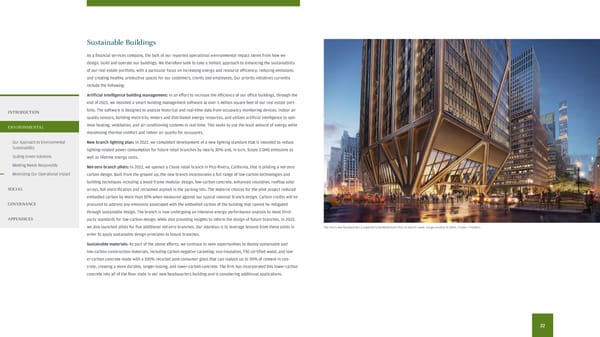Sustainable Buildings As a fnancial services company, the bulk of our reported operational environmental impact stems from how we design, build and operate our buildings. We therefore seek to take a holistic approach to enhancing the sustainability of our real estate portfolio, with a particular focus on increasing energy and resource efciency; reducing emissions; and creating healthy, productive spaces for our customers, clients and employees. Our priority initiatives currently include the following: Artifcial Intelligence building management: In an efort to increase the efciency of our ofce buildings, through the end of 2022, we installed a smart building management software at over 5 million square feet of our real estate port- INTRODUCTION folio. The software is designed to analyze historical and real-time data from occupancy monitoring devices, indoor air quality sensors, building electricity meters and distributed energy resources, and utilizes artifcial intelligence to opti- ENVIRONMENTAL mize heating, ventilation, and air conditioning systems in real-time. This seeks to use the least amount of energy while maximizing thermal comfort and indoor air quality for occupants. Our Approach to Environmental New branch lighting plan: In 2022, we completed development of a new lighting standard that is intended to reduce Sustainability lighting-related power consumption for future retail branches by nearly 30% and, in turn, Scope 2 GHG emissions as Scaling Green Solutions well as lifetime energy costs. Meeting Needs Responsibly Net-zero branch pilots: In 2022, we opened a Chase retail branch in Pico Rivera, California, that is piloting a net-zero Minimizing Our Operational Impact carbon design. Built from the ground up, the new branch incorporates a full range of low-carbon technologies and building techniques including a wood frame modular design, low-carbon concrete, enhanced insulation, rooftop solar SOCIAL arrays, full electrifcation and reclaimed asphalt in the parking lots. The material choices for the pilot project reduced embodied carbon by more than 10% when measured against our typical national branch design. Carbon credits will be GOVERNANCE procured to address any emissions associated with the embodied carbon of the building that cannot be mitigated through sustainable design. The branch is now undergoing an intensive energy performance analysis to meet third- APPENDICES party standards for low-carbon design, while also providing insights to inform the design of future branches. In 2022, we also launched pilots for fve additional net-zero branches. Our intention is to leverage lessons from these pilots in The Firm’s new headquarters is expected to be Manhattan’s frst all-electric tower. Image courtesy of DBOX / Foster + Partners. order to apply sustainable design principles to future branches. Sustainable materials: As part of the above eforts, we continue to seek opportunities to deploy sustainable and low-carbon construction materials, including carbon negative carpeting, eco-insulation, FSC-certifed wood, and low- er-carbon concrete made with a 100% recycled post-consumer glass that can replace up to 50% of cement in con- crete, creating a more durable, longer-lasting, and lower-carbon concrete. The frm has incorporated this lower-carbon concrete into all of the foor slabs in our new headquarters building and is considering additional applications. 22
 2022 Environmental Social Governance Report Page 23 Page 25
2022 Environmental Social Governance Report Page 23 Page 25